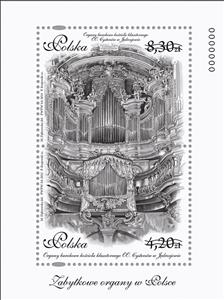Souvenir Sheet: Baroque organ in the church of the Cistercian Fathers in Jęd (Poland 2015)
Baroque organ in the church of the Cistercian Fathers in Jęd (Poland 2015)
30 July (Poland ) within release The historic organ in Poland goes into circulation Souvenir Sheet Baroque organ in the church of the Cistercian Fathers in Jęd face value 4.20+8.30 No Face Value
| Souvenir Sheet Baroque organ in the church of the Cistercian Fathers in Jęd in catalogues | |
|---|---|
| Polish Stamps Catalog (Fischer): | Pol:PL 4628-4629ND |
Souvenir Sheet is vertical format.
Also in the issue The historic organ in Poland:
- Stamp - Baroque organ in the church of the Cistercian Fathers in Jęd face value 4.20;
- Mini Sheet - Baroque organ in the church of the Cistercian Fathers in Jęd face value 12.50;
- Souvenir Sheet - Baroque organ in the church of the Cistercian Fathers in Jęd face value 4.20+8.30;
- Stamp - Baroque organ in the church of the Cistercian Fathers in Jęd face value 8.30;
- First Day Cover - The historic organ in Poland face value 12.50;
Souvenir Sheet Baroque organ in the church of the Cistercian Fathers in Jęd it reflects the thematic directions:
A musical instrument is a device created or adapted to make musical sounds. In principle, any object that produces sound can be considered a musical instrument—it is through purpose that the object becomes a musical instrument. A person who plays a musical instrument is known as an instrumentalist. The history of musical instruments dates to the beginnings of human culture. Early musical instruments may have been used for rituals, such as a horn to signal success on the hunt, or a drum in a religious ceremony. Cultures eventually developed composition and performance of melodies for entertainment. Musical instruments evolved in step with changing applications and technologies.
he Baroque or Baroquism is a Western style of architecture, music, dance, painting, sculpture, poetry, and other arts that flourished from the early 17th century until the 1750s. It followed Renaissance art and Mannerism and preceded the Rococo (in the past often referred to as "late Baroque") and Neoclassical styles. It was encouraged by the Catholic Church as a means to counter the simplicity and austerity of Protestant architecture, art, and music, though Lutheran Baroque art developed in parts of Europe as well
A church building, often simply called a church, is a building used for Christian religious activities, particularly worship services. The term in its architectural sense is most often used by Christians to refer to their religious buildings, but it is sometimes used (by analogy) for buildings of other religions. In traditional Christian architecture, the church is often arranged in the shape of a Christian cross. When viewed from plan view the longest part of a cross is represented by the aisle and the junction of the cross is located at the altar area. Towers or domes are often added with the intention of directing the eye of the viewer towards the heavens and inspiring church visitors. Modern church buildings have a variety of architectural styles and layouts; many buildings that were designed for other purposes have now been converted for church use; and, similarly, many original church buildings have been put to other uses. The earliest identified Christian church was a house church founded between 233 and 256. During the 11th through 14th centuries, a wave of building of cathedrals and smaller parish churches occurred across Western Europe. A cathedral is a church, usually Roman Catholic, Anglican, Oriental Orthodox or Eastern Orthodox, housing the seat of a bishop.


